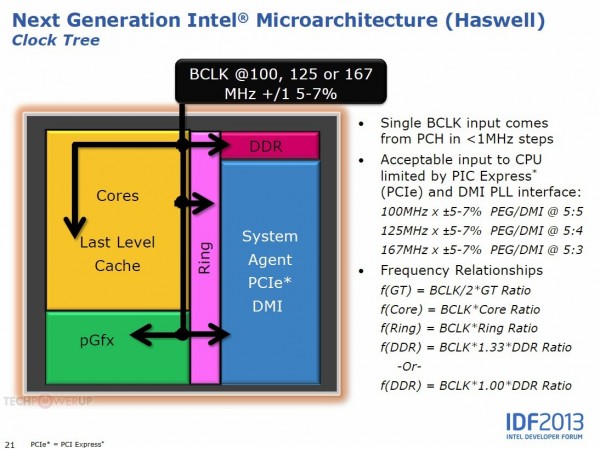Quite similar to Sandy Bridge-E
During its Intel Developer Forum (IDF) 2013 event held in Bejing, Intel decided it is time to shed some details regarding overclocking capabilities of its upcoming Haswell CPUs.
According to first details it appears that Haswell might be much easier to overclock and the experience should be similar to the Sandy Bridge-E. All Haswell CPUs will ship with a base clock of 100MHz and some other components will also be linked to that frequency. Overclockers will start with a 5 to 7 percent headroom for tweaking this frequency.
Ohter features include a choice between three base clocks, 100MHz, 125MHz and 166MHz. The good part of the story is that other components should auto-adjust to it and thus stability should remain unaffected. The 7 percent limit was based on a fact that if you go over it it would destabilize both PCI-Express and DMI-PLL clock domains whic. On the other hand, the unlocked -K parts will have an unlocked multiplier that will reach up to 80x on 100MHz, up to 64x on 125MHz and up to 48x on 166MHz. By the looks of it, we could see some impressive overclocking results with these unlocked -K parts of Haswell.
As far as the voltage goes, an important part for overclocking, Intel announced a new integrated voltage regulation (iVR). In short, CPUs will come with its own integrated VRM and will not rely on the VRM implementation on the motherboard. Of course, in order to get most of it, you'll need to go for a high-end motherboard with impressive VRM but the actual controller for it will now be in the CPU itself.
The new iVR will offer two voltage tweaks, the vCCIN and VDDQ. The vCCIN wil handle vCORE for CPU, vRING for ring-bus that connects everything to the CPU, vSA/vIOA/vIOD that will handle integrated northbridge as well as the vGT that handles voltage for integrated GPU, while vDDQ handles RAM voltage.
The overclocking info means that every Haswell based CPU will be overclockable, at least to some extent. Of course, unlocked -K parts will have much more potential but it will surely be interesting on how far could you be able to push those non-K parts as well.



Source: Techpowerup.com
According to first details it appears that Haswell might be much easier to overclock and the experience should be similar to the Sandy Bridge-E. All Haswell CPUs will ship with a base clock of 100MHz and some other components will also be linked to that frequency. Overclockers will start with a 5 to 7 percent headroom for tweaking this frequency.
Ohter features include a choice between three base clocks, 100MHz, 125MHz and 166MHz. The good part of the story is that other components should auto-adjust to it and thus stability should remain unaffected. The 7 percent limit was based on a fact that if you go over it it would destabilize both PCI-Express and DMI-PLL clock domains whic. On the other hand, the unlocked -K parts will have an unlocked multiplier that will reach up to 80x on 100MHz, up to 64x on 125MHz and up to 48x on 166MHz. By the looks of it, we could see some impressive overclocking results with these unlocked -K parts of Haswell.
As far as the voltage goes, an important part for overclocking, Intel announced a new integrated voltage regulation (iVR). In short, CPUs will come with its own integrated VRM and will not rely on the VRM implementation on the motherboard. Of course, in order to get most of it, you'll need to go for a high-end motherboard with impressive VRM but the actual controller for it will now be in the CPU itself.
The new iVR will offer two voltage tweaks, the vCCIN and VDDQ. The vCCIN wil handle vCORE for CPU, vRING for ring-bus that connects everything to the CPU, vSA/vIOA/vIOD that will handle integrated northbridge as well as the vGT that handles voltage for integrated GPU, while vDDQ handles RAM voltage.
The overclocking info means that every Haswell based CPU will be overclockable, at least to some extent. Of course, unlocked -K parts will have much more potential but it will surely be interesting on how far could you be able to push those non-K parts as well.



Source: Techpowerup.com
News by Luca Rocchi and Marc Büchel - German Translation by Paul Görnhardt - Italian Translation by Francesco Daghini
Previous article - Next article
comments powered by Disqus
comments powered by Disqus